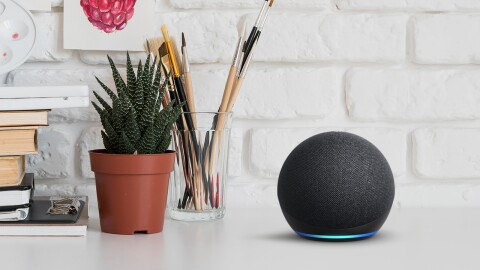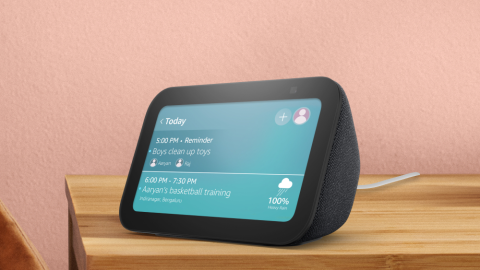Anne Toth recently joined the Alexa Trust team at Amazon. We had the opportunity to connect with Anne to learn more about the team and how they think about customer trust, as well as her past experience working in technology.
Q: You recently joined the Alexa Trust team, but have a long history of working in technology. Is there anything you’ve learned since joining Amazon that has surprised you?
As an Alexa customer myself, I came to this job knowing how helpful Alexa is. But the breadth and scope of what Alexa is capable of was something I don't think I truly understood before joining the team. Nor did I really comprehend the kind of meaningful impact Alexa can have in people's lives, particularly people with disabilities. Customers with mobility impairments have shared stories about how they use Alexa's voice features with smart home devices to manage their entire household. A person who is blind or with low vision can hold up an object to Echo Show devices and Alexa will tell them what it is. These are just a few examples of what Alexa can do with much more to come.
When most people think about trust, privacy and security immediately come to mind and they're always at the top of the priority list. I also think about trust more broadly—from accessibility to ethics and bias in AI. These are all different issues but are related in that they are grounded in requiring customer trust. The future we envision for Alexa is not possible unless we earn and continually re-earn our customers' trust in us.
For me, the best part about working on the Alexa Trust team is helping to realize the potential for Alexa to not just be useful, but to help earn the right to be essential to the lives of millions of people worldwide.
Q: On accessibility, how do you think about making technology that is accessible and useful to all?
Earlier in my career, back in the early days of the web, the company I was with received feedback from blind customers that our products were not compatible with their screen reader software. To better understand the problem, I commissioned a usability study and reached out to advocacy organizations for guidance. What was most impactful about that experience was the realization that making accessible products is, in many cases, straightforward if not trivial. Which is why it was disheartening that many products available then were developed with a complete disregard for much of the population. That experience moved me from the "concerned citizen" bucket to "unapologetically vocal advocate."
One of the reasons I wanted to join the Alexa Trust team is because this team is also responsible for designing accessible experiences across Alexa. The inclusivity that's accounted for in the development of products we're working on, and seeing how far we have come in the industry, is incredibly gratifying. Voice has democratized technology for a lot of people. It's humbling and exciting to see how Alexa has helped customers with different needs—from people who are blind, to people with mobility impairments or memory loss. Customers tell us how Alexa has made life easier, given them more independence, and even become a part of their family. I'm excited to continue working alongside the team in this area.
Q: The team recently launched a number of new things—from a new Echo Show that can move with you, to the ability for Alexa to detect sounds. How are teams at Amazon thinking about innovation, while balancing privacy?
Too often innovation and privacy are presented as opposing goals and we ask the question in terms of striking a "balance" between them. I would argue that you can have both innovation and privacy—you don't need to choose one over the other when privacy is designed into the experience. Year after year, the Alexa Privacy team has continued to introduce improvements in privacy features that are available to customers including voice-enabled privacy controls and more ways to manage their voice recordings.
And the amazing thing about joining Amazon and this team is witnessing how privacy has been incorporated into the design process since the inception of Alexa. After working in technology for over 20 years, I've seen first-hand how challenging it can be for companies to retrofit privacy controls and features into existing products and services. Privacy by design is not a platitude with the Alexa team, it's a daily operational reality. This strong foundation in privacy makes it easy to layer and build upon. From my standpoint, it's unique to get to join a team and work on a service that is this far along in their thinking and processes.
Q: What do customers want to hear from companies about privacy? What can you do to give them re-assurance that they can trust technology?
The chasm between what most people understand and the way many technologies work is growing daily. I say this not to stoke fear or anxiety, but to be brutally honest about the challenges technology companies face right now. Technology offers incredible benefits to customers, but for everyone to realize those benefits, we are basically saying, "It's okay, trust us." We have to earn that trust up-front and every day following.
We all know that trust isn't built with just one interaction. It needs to be built into every interaction you have with your customers so that the technology is easy for them to use. The onus is on us to make sure we're incorporating trust into the experience, the controls we offer, and the information we make available to customers.
Here are some concrete examples. It was an early design decision to have Echo devices display a visual light indicator when they detect the wake word. That's an interaction that helps build trust because you know your device will always give you an indication by displaying the light ring or playing an audible tone when Alexa wakes up and is processing your voice request. Another example of how we look to build trust is through the Alexa Privacy Hub. We always look for new ways to improve our privacy content and controls so that we're providing customers tools to help them feel confident in understanding how Alexa and Echo devices work. My goal is to be upfront and transparent with customers about the experience they will have and to continue to be worthy of the trust they place in us.
Q: There are a number of privacy controls customers can choose from. How should customers decide which setting to turn on?
The way we've designed privacy into Alexa should be a baseline that meets the needs of the majority of our customers—it just works as it is. However, we also recognize that people want to customize and manage their experiences to suit their specific needs. Privacy choices are important and there's huge variation in how people think about them—some of it's generational, some of it's cultural. There has to be a range of settings to help people customize their experience. But, you shouldn't feel like you have to set up these things, because privacy is built into the experience inherently. That's why we spend so much time thinking about privacy in the development phase. If customers decide to do nothing, they can know and feel confident that their privacy is protected regardless.











